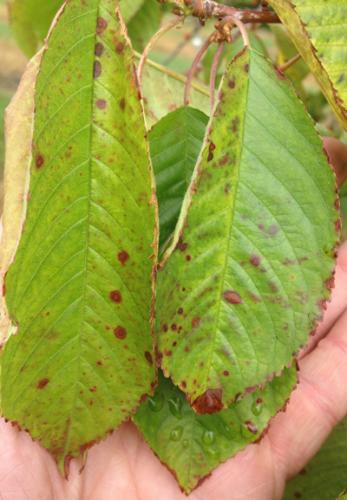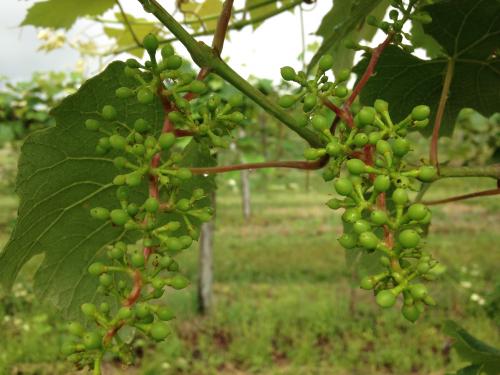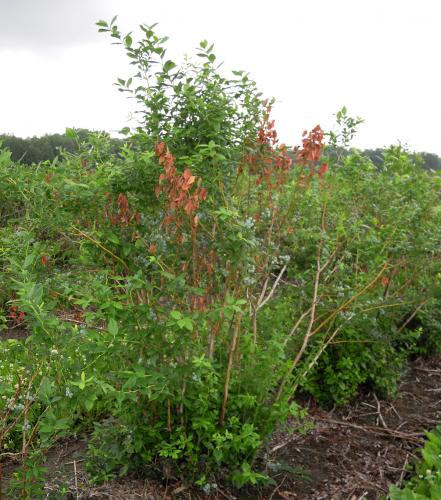Southwest Michigan fruit regional report – June 16, 2015
Wet weather is hampering summer fruit harvest as well as insect and disease control efforts.

Weather
Last week was warm and humid. High temperatures alternated between the high 70s and low 80s. Low temperatures were in the 50s and 60s. Rain showers alternated with fair conditions as well. The heaviest storms crossed the region Friday and Sunday, June 12-13. Rainfall totals last week ranged from over an inch to almost 4 inches. Across the region, rainfall averaged 2.2 inches. Thunderstorms and showers moved through the area again Monday, June 15, dropping another 1-2 inches. Soils are very wet.
Weather for the upcoming week will be similar to last week with high temperatures near the 80s and lows in the 60s. Thunderstorms and showers are possible most of the week. With the rain over the last two weeks, our rainfall totals are just above average for the year. We are close to normal in terms of crop development and growing degree day (GDD) accumulations. With the warm weather last week, we picked up about 28 GDD base 45 and 21.5 base 50 per day.
Southwest Michigan GDD Summary from Jan. 1 to June 14, 2015 |
|||
|---|---|---|---|
|
Station |
GDD 42 F |
GDD 45 F |
GDD 50 F |
|
Benton Harbor (SWMRC) |
1,200 |
998 |
710 |
|
Lawton (Lawton) |
1,241 |
1,037 |
737 |
|
Fennville (TNRC) |
1,056 |
869 |
604 |
|
Average for the region |
1,205 |
1,003 |
714 |
|
Accumulation last week |
196 |
176 |
150 |
Tree fruit
We have gone from adequate rainfall to excessive rainfall. Some growers are concerned about damage to young orchards from standing water. Obliquebanded leafroller egg hatch is predicted to begin in some orchards at the end of this week. San Jose crawler emergence is predicted in southwest Michigan about June 13, based on trap catches at the Trevor Nichols Research Center in Fennville, Michigan. Summer materials for San Jose control are often timed to control crawlers. See the “2015 Michigan Fruit Management Guide” (E0154) for more information. Fruit growers who suffered plant loss due to severe winter cold the past two winters should contact the Farm Service Agency (FSA) to document the loss. Read the article, “Relief may be available for fruit, nut and ornamental growers with winter injury,” from Michigan State University Extension for more information.
The largest apricot fruit are over 2 inches in diameter.
Peaches are growing rapidly. Fruit are 1.25 inches in diameter with the pits still soft. Red Haven harvest is predicted for Aug. 3 in central Berrien County. Foliage of winter-damaged twigs looks weak on some varieties. Fungicide treatments for rusty spot should continue until pit hardening for varieties such as Loring, Bellaire and other peaches with showy bloom that tend to be more susceptible to this disease. Bacterial spot symptoms are slowly building up on leaves of susceptible varieties. Mycoshield, with a 21-day pre-harvest interval (PHI) restriction, is the best tool now to keep bacterial spot from building up on foliage. Oriental fruit moth adult catch from the first generation flight is declining. Shoot tip flagging caused by burrowing oriental fruit moth larvae has been reported at several sites. Plum curculio and tarnished plant bugs continue to be a concern.
Sweet cherries are 16 to 18 millimeters in diameter and a heavy drop of fruit has begun. This dropped fruit appears normal and to have been ripening normally. Severe leaf spotting due to Captan fungicide use after shuck split showed up in some orchards over the last two weeks. Fruit drop and leaf spotting vary between varieties. Rain cracking of fruit has not shown up, but cracking is a concern with the continuing rain. Bird feeding on cherries is a problem in early ripening varieties. Cherry leaf spot lesions are just beginning to appear. Cherry leaves are always susceptible to cherry leaf spot; apply protectant fungicides before rain events. Warm rains are good infection periods for brown rot as well, and sweet cherries are susceptible to brown rot at all stages of development.

Captan injury symptoms on sweet cherry. Long periods of cool, moist weather resulted in a cuticle that was not as waxy as normal and Captan is causing spotting of the leaves in sweet cherries. Photo credit: Bill Shane, MSU Extension.
Tart cherries are 12 millimeters in diameter and are turning straw-colored. Crop potential generally still looks good. Growers need to continue to protect against cherry leaf spot. Cherry leaves are susceptible to this disease after bloom and protection needs to be maintained throughout the season. Tart cherries are moderately tolerant to copper applications that can help reduce bacterial canker and cherry leaf spot in cherries. A few growers are reporting the beginning of cherry leaf spot symptoms. With all the rain and long wetting periods, we are seeing extreme cherry leaf spot pressure. Growers can use the Enviro-weather forecast model for cherry leaf spot to help guide their sprays and track infection periods. Cherry fruit flies have not shown up in the Trevor Nichols Research Center trapline.
Japanese plums are about 1 inch in diameter and European plums are up to 0.75 inches in diameter. Fruit and leaf russet due to chemical phytotoxicity are common, including Captan-induced russet. Plum fruit and leaves are susceptible to bacterial leaf spot, but Mycoshield is not labeled for use on plums. Growers need to also protect the current season’s growth against black knot until shoot growth ceases later in the season. Plum curculio egglaying activity should be decreasing.
Apple fruits are up to 1.25 inches in diameter for main season varieties and up to 1.5 inches in diameter for summer apple varieties. Hand-thinning is underway in many orchards to break up clusters of fruit. Secondary apple scab is common in some orchards and unsprayed trees are shedding infected leaves. Bright yellow cedar apple rust symptoms are also common in some orchards. New fire blight symptoms are still showing up in area orchards, but are still relatively rare. Codling moth egglaying and hatch is still underway for first generation. We expect to see oriental fruit moth larvae damage to fruit this week.
Pear crop potential is generally good. Bartlett average up to 1.125 inches in diameter and Harrow Sweet are 0.875 inches in diameter. Growers are removing watersprouts from trees in order to discourage pear psylla populations. Pear psylla numbers are increasing.
Small fruit
Grape bloom is ending in juice grapes and is underway in hybrid and many vinifera wine grapes. During bloom and early fruit development, grape flower and fruit clusters are vulnerable to infection from powdery mildew, downy mildew, black rot and phomopsis, and latent infections of Botrytis. Now is the time to apply protectant and systemic fungicides with activity against all of these diseases. See “Protect grape clusters from all major grape diseases during early fruit development” for more information. Leaf infections of phomopsis, black rot and downy mildew are appearing where early-season coverage was not achieved. The risk of fruit and flower infection increases when there is rain during bloom, especially if it is followed by a long wetting period. Growers who didn’t apply fungicide before Sunday’s rain should apply materials with back action activity.
First generation grape berry moth flight is ending, and larvae are webbing in the clusters. Berry loss this early in the season is compensated by later berry growth, and sprays for these larvae are not recommended in most cases. MSU Extension recommends most growers do not need to spray for grape berry moths until second generation egglaying. Wild grape bloom was around May 26 in Berrien County and June 1 in Van Buren County, varying somewhat from farm to farm. This date is used in the grape berry moth model to time insecticide applications for second and third generation egglaying.
Rose chafers were reported last week in Berrien County. Scout wine grapes for potato leafhoppers in the coming weeks, which arrive on storms and wind from the south. Look for grape leafhoppers in juice grapes. Usually only severe outbreaks of these insects require treatment.

Small grape berries in Niagara grapes immediately following bloom. Photo credit: Brad Baughman, MSU Extension
Blueberry fruit are sizing well with all the rain. Many growers turned on their irrigation systems, but have seen little use as we received 3 to 5 inches of rain since the beginning of June. Water is standing in many fields. The crop varies from field to field and bush to bush within the field. Fields in cold sites have a light crop due to winter cold injury. Phomopsis cane blight symptoms continue to appear earlier than normal. Two- and three-year-old canes are affected as well as shoots which emerged last year.
Cherry fruitworms and cranberry fruitworms have been flying for several weeks and laying eggs on green fruit. The large flight of cranberry fruitworm continues. Most growers have applied insecticides to control these insects and fungicides to protect the green fruit from anthracnose fruit rots and stem blights such as phomopsis. Growers with vigorous growth from the base of the plants should be sure to direct some fungicide in the new shoots to be sure and protect these tissues as well for shoot diseases. See “Young cane dieback becoming obvious in Michigan blueberry fields” for more information.

Cane blight symptoms of phomopsis are appearing in canes that are several years old. Photo credit: Mark Longstroth, MSU Extension
Strawberry harvest is underway. Fruit size and quality has been excellent. Rain has hampered harvest and will probably bring an early end to harvest in some fields. Wet fruit is more susceptible to rots.
Raspberry bloom is ending and fruit is developing rapidly. Blackberry bloom continues. Avoid using insecticides during bloom. Apply fungicides when bees are not foraging on the bloom. Scout black raspberries and blackberries for signs of orange rust and remove infected plants. For growers concerned about raspberry viruses, MSU Extension has received a grant to survey for viruses. See “Assistance in raspberry virus diagnosis offered” for more information.
Upcoming meetings
Our next Monday fruit IPM meeting is June 21 at Fruit Acres Farms, 3452 Friday Rd, south of Coloma, MI 49038, at 5 p.m. Two Michigan pesticide applicator recertification credits will be given for these meetings.
See also
- Rainfast characteristics of insecticides on fruit
- The challenges of disease control during rainy spells
- Scouting for blossom blight symptoms of fire blight in apples
- Where else do Spotted Wing Drosophila like to feed?
- Protect grape clusters from all major grape diseases during early fruit development



 Print
Print Email
Email
